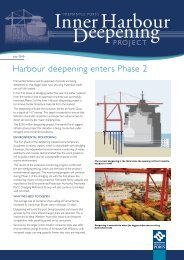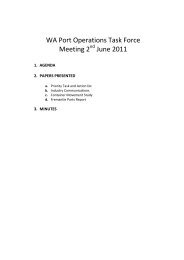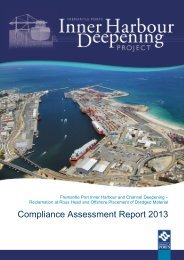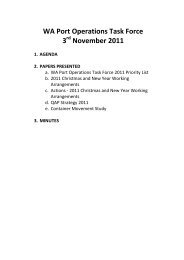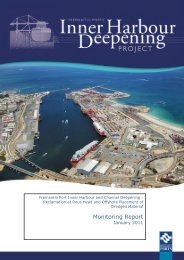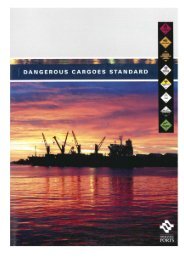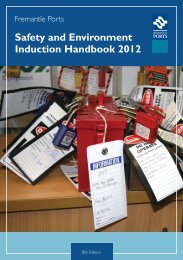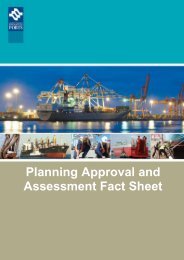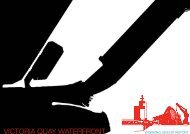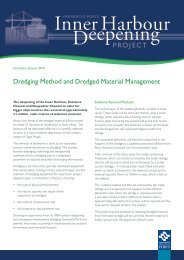Fremantle Port Inner Harbour and Channel ... - Fremantle Ports
Fremantle Port Inner Harbour and Channel ... - Fremantle Ports
Fremantle Port Inner Harbour and Channel ... - Fremantle Ports
- No tags were found...
Create successful ePaper yourself
Turn your PDF publications into a flip-book with our unique Google optimized e-Paper software.
Limitations <strong>and</strong> assumptionsA number of limitations <strong>and</strong> assumptions were identified throughout the classification process asoutlined below.Key Issues associated with substrate mappingGeoimage appreciates that substrate mapping is dependent on the following conditions:Range <strong>and</strong> type of substrates throughout the area of interest;Preference for a light coloured, uniform substrate;Appropriate wind conditions to limit water surface glint;Appropriate swell conditions to limit wave refraction artefacts;Appropriate capture angle for the imagery i.e. 0 – 20 degrees off nadir likely to achieve goodbathymetric outcomes, with angles closer to nadir offering the best outcomes;Appropriate tidal conditions to limit turbidity due to tidal changes; <strong>and</strong>,Appropriate current movement to limit turbidity due to significant water flows.There are specific conditions, including capture angle <strong>and</strong> date of capture between the two scenes,which have caused some challenges for the substrate mapping between scenes.Imagery Acquisition ConditionsWater conditions at the time of acquisition are a critical factor in determining the level of detail whichcan be detected <strong>and</strong> classified. There were two scenes acquired over this site from two differentsensors across multiple dates. The acquisition conditions of the two scenes were variable. Theresultant colouring <strong>and</strong> contrast levels of submerged or emergent features at varying depths underdifferent water conditions at the time of the image acquisitions meant the two scenes were treatedseparately <strong>and</strong> could not be mosaicked.Where the GE-1 data was available over the site, the output classification was based on this data.The WV-2 data was only used in locations where it was the only available data source. While 8-b<strong>and</strong>information can detect substrates at greater depths than other sensors, this only applies in good waterquality <strong>and</strong> environmental conditions. For this site, the conditions at the time of acquisition were notfavourable for the discrimination of substrates at depths greater than 15m. The GE-1 scene was morefavourable to identify sea-floor features compared to the WV-2 scene <strong>and</strong> therefore became theprimary scene for analysis.Spatial ScaleTo reduce any influence of misregistration, a minimum mapping area of 3 x 3 pixels or 36 squaremetres was used, corresponding to nine pixels. This was carried out to improve the accuracy ofdetecting real substrate features <strong>and</strong> boundaries. The noise in the data generated by waves <strong>and</strong>remaining glint impacted the spatial scale of the classification.Classification scale <strong>and</strong> automationThe two tiers mapped in this hierarchical classification form a broad then detailed classification of thesubstrates in this region. Further refinement could be made should suitable archive satellite imagerybecome available over the site for future mapping at a more detailed classification scale. In somelocations, water depth prevented the classification from being assigned to the Tier 2 class <strong>and</strong> theTier 1 class was deemed the limit of the classification scale in these locations (usually at depthsgreater than 20m experiencing compounding artefacts such as sun glint, <strong>and</strong>/or wave refraction).While a range of substrates was observed in the field data, only Rock, S<strong>and</strong> <strong>and</strong> Seagrass were ableto be detected <strong>and</strong> mapped with confidence given the depth of the overall site <strong>and</strong> the artefactsacross the imagery. This project required the manual assignment of Tier 1 <strong>and</strong> Tier 2 classes.Quality AssuranceAn independent review within the vector GIS environment was undertaken to visually assess theassignment of classes. Field data was not able to be used as an independent, quantitative accuracyassessment tool in this project as the field data became vital as input to the classification process dueto the artefacts existing in the imagery for this project. Metadata was also supplied which complieswith AZ/NZS ISO 19115:2005 st<strong>and</strong>ards.Specialists in Satellite Imagery <strong>and</strong> Geospatial Solutions | Commercial in confidence Page | 10



